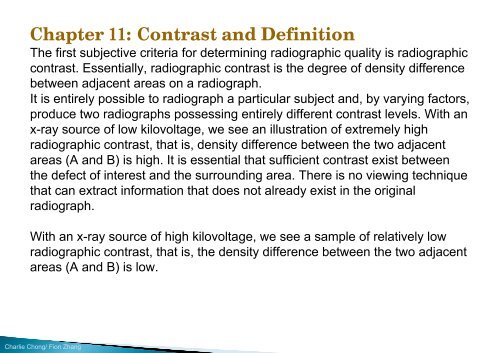Understanding NRT- Reading 1- 2 of 2- Radiogaphic Testing A
Understanding nrt reading 1- 2 of 2- radiogaphic testing a
Understanding nrt reading 1- 2 of 2- radiogaphic testing a
You also want an ePaper? Increase the reach of your titles
YUMPU automatically turns print PDFs into web optimized ePapers that Google loves.
Chapter 11: Contrast and Definition<br />
The first subjective criteria for determining radiographic quality is radiographic<br />
contrast. Essentially, radiographic contrast is the degree <strong>of</strong> density difference<br />
between adjacent areas on a radiograph.<br />
It is entirely possible to radiograph a particular subject and, by varying factors,<br />
produce two radiographs possessing entirely different contrast levels. With an<br />
x-ray source <strong>of</strong> low kilovoltage, we see an illustration <strong>of</strong> extremely high<br />
radiographic contrast, that is, density difference between the two adjacent<br />
areas (A and B) is high. It is essential that sufficient contrast exist between<br />
the defect <strong>of</strong> interest and the surrounding area. There is no viewing technique<br />
that can extract information that does not already exist in the original<br />
radiograph.<br />
With an x-ray source <strong>of</strong> high kilovoltage, we see a sample <strong>of</strong> relatively low<br />
radiographic contrast, that is, the density difference between the two adjacent<br />
areas (A and B) is low.<br />
Charlie Chong/ Fion Zhang


















